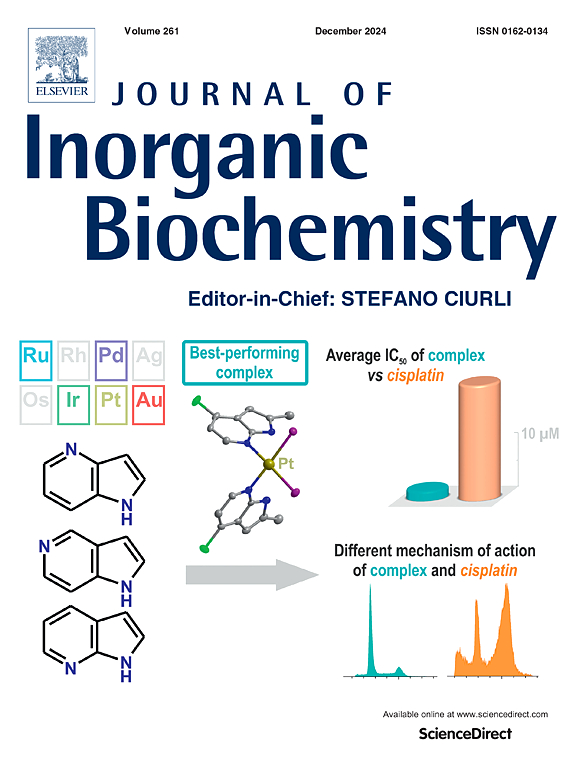Lysosome-targeted theranostics: Integration of real-time fluorescence imaging and controlled drug delivery via Zn(II)-Schiff Base complexes
IF 3.2
2区 化学
Q2 BIOCHEMISTRY & MOLECULAR BIOLOGY
引用次数: 0
Abstract
The development of lysosome-targeted theranostic platforms stands at the forefront of precision oncology. However, significant challenges persist in synchronizing real-time diagnostic imaging with spatiotemporal controlled therapeutic delivery. Current systems commonly encounter issues such as suboptimal quantum yields, pH-insensitive release kinetics, and spectral interference between imaging and drug-tracking modes. To address these limitations, we rationally designed a novel series of Zn(II)-Schiff base complexes through coordination chemistry to achieve lysosomal targeting, enhanced optical properties, and microenvironment-responsive drug release. Optical characterization revealed significant red shifts in the absorption and emission spectra after Zn(II) coordination, which can be attributed to the reduction in energy bandgap. Among these complexes, Zn-((2,5-diamino-1,4-benzenedithiol dihydrochloride)-(2,4-Dihydroxybenzaldehyde)) (Zn-MTDH) exhibited the highest quantum yield (63.7 %) and enabled high-contrast lysosomal imaging in 4 T1 breast cancer cells, positioning it as a promising candidate for biological applications. When loaded with camptothecin (CPT), CPT@Zn-MTDH displayed pH-dependent drug release kinetics (81 % cumulative release at pH 5.6 vs. 51 % at pH 7.4 over 36 h). Cellular assays demonstrated that Zn-MTDH exhibits low cytotoxicity and excellent biocompatibility. In contrast, CPT@Zn-MTDH exhibited enhanced cytotoxicity compared to free CPT, highlighting the potential of these complexes for lysosome-targeted cancer therapy. This study establishes Zn(II)-Schiff base complexes as a versatile “track-and-treat” theranostic platform, thereby bridging diagnostic precision with therapeutic efficacy.
溶酶体靶向治疗:实时荧光成像和通过Zn(II)-希夫碱配合物控制给药的集成
溶酶体靶向治疗平台的发展处于精准肿瘤学的前沿。然而,在同步实时诊断成像与时空控制治疗递送方面仍然存在重大挑战。当前的系统通常会遇到诸如次优量子产率、ph不敏感释放动力学以及成像和药物跟踪模式之间的光谱干扰等问题。为了解决这些限制,我们通过配位化学合理设计了一系列新的Zn(II)-希夫碱配合物,以实现溶酶体靶向,增强光学性质和微环境响应性药物释放。光学表征表明,锌(II)配位后,吸收光谱和发射光谱发生了明显的红移,这可归因于能带隙的减小。在这些配合物中,Zn-((2,5-二氨基-1,4-苯二硫醇二盐酸)-(2,4-二羟基苯甲醛))(Zn- mtdh)表现出最高的量子产率(63.7%),并在4 T1乳腺癌细胞中实现了高对比度溶酶体成像,使其成为生物学应用的有希望的候选者。当装载喜树碱(CPT)时,CPT@Zn-MTDH显示pH依赖的药物释放动力学(在36小时内,pH 5.6累积释放81%,pH 7.4累积释放51%)。细胞实验表明,锌- mtdh具有较低的细胞毒性和良好的生物相容性。相比之下,CPT@Zn-MTDH与游离CPT相比,显示出增强的细胞毒性,突出了这些复合物在溶酶体靶向癌症治疗中的潜力。本研究建立了锌(II)-希夫碱配合物作为一种多功能的“跟踪治疗”治疗平台,从而将诊断精度与治疗效果联系起来。
本文章由计算机程序翻译,如有差异,请以英文原文为准。
求助全文
约1分钟内获得全文
求助全文
来源期刊

Journal of Inorganic Biochemistry
生物-生化与分子生物学
CiteScore
7.00
自引率
10.30%
发文量
336
审稿时长
41 days
期刊介绍:
The Journal of Inorganic Biochemistry is an established international forum for research in all aspects of Biological Inorganic Chemistry. Original papers of a high scientific level are published in the form of Articles (full length papers), Short Communications, Focused Reviews and Bioinorganic Methods. Topics include: the chemistry, structure and function of metalloenzymes; the interaction of inorganic ions and molecules with proteins and nucleic acids; the synthesis and properties of coordination complexes of biological interest including both structural and functional model systems; the function of metal- containing systems in the regulation of gene expression; the role of metals in medicine; the application of spectroscopic methods to determine the structure of metallobiomolecules; the preparation and characterization of metal-based biomaterials; and related systems. The emphasis of the Journal is on the structure and mechanism of action of metallobiomolecules.
 求助内容:
求助内容: 应助结果提醒方式:
应助结果提醒方式:


